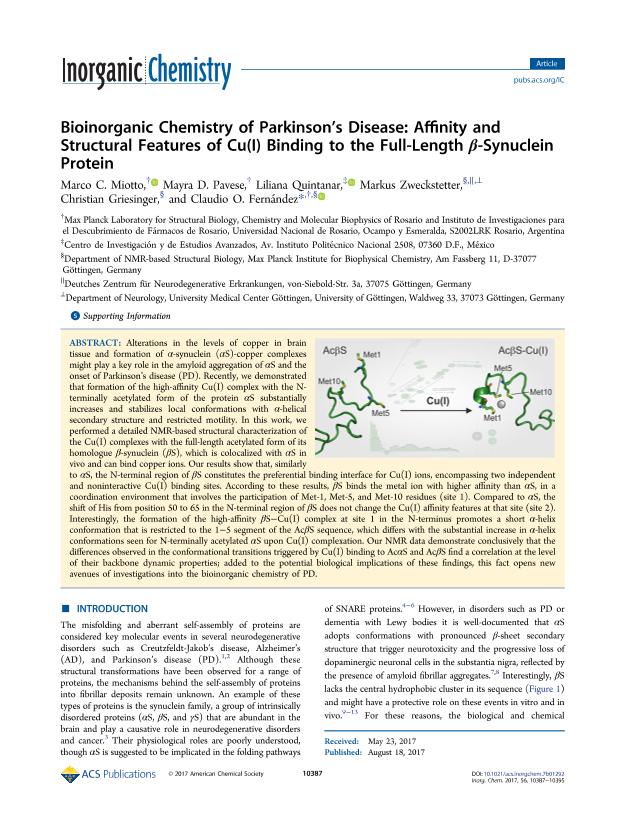Mostrar el registro sencillo del ítem
dc.contributor.author
Miotto, Marco César

dc.contributor.author
Pavese, Mayra D.
dc.contributor.author
Quintanar, Liliana

dc.contributor.author
Zweckstetter, Markus
dc.contributor.author
Griesinger, Christian
dc.contributor.author
Fernandez, Claudio Oscar

dc.date.available
2018-06-28T15:35:04Z
dc.date.issued
2017-09
dc.identifier.citation
Miotto, Marco César; Pavese, Mayra D.; Quintanar, Liliana; Zweckstetter, Markus; Griesinger, Christian; et al.; Bioinorganic Chemistry of Parkinson's Disease: Affinity and Structural Features of Cu(I) Binding to the Full-Length β-Synuclein Protein; American Chemical Society; Inorganic Chemistry; 56; 17; 9-2017; 10387-10395
dc.identifier.issn
0020-1669
dc.identifier.uri
http://hdl.handle.net/11336/50367
dc.description.abstract
Alterations in the levels of copper in brain tissue and formation of α-synuclein (αS)-copper complexes might play a key role in the amyloid aggregation of αS and the onset of Parkinson's disease (PD). Recently, we demonstrated that formation of the high-affinity Cu(I) complex with the N-terminally acetylated form of the protein αS substantially increases and stabilizes local conformations with α-helical secondary structure and restricted motility. In this work, we performed a detailed NMR-based structural characterization of the Cu(I) complexes with the full-length acetylated form of its homologue β-synuclein (βS), which is colocalized with αS in vivo and can bind copper ions. Our results show that, similarly to αS, the N-terminal region of βS constitutes the preferential binding interface for Cu(I) ions, encompassing two independent and noninteractive Cu(I) binding sites. According to these results, βS binds the metal ion with higher affinity than αS, in a coordination environment that involves the participation of Met-1, Met-5, and Met-10 residues (site 1). Compared to αS, the shift of His from position 50 to 65 in the N-terminal region of βS does not change the Cu(I) affinity features at that site (site 2). Interestingly, the formation of the high-affinity βS-Cu(I) complex at site 1 in the N-terminus promotes a short α-helix conformation that is restricted to the 1-5 segment of the AcβS sequence, which differs with the substantial increase in α-helix conformations seen for N-terminally acetylated αS upon Cu(I) complexation. Our NMR data demonstrate conclusively that the differences observed in the conformational transitions triggered by Cu(I) binding to AcαS and AcβS find a correlation at the level of their backbone dynamic properties; added to the potential biological implications of these findings, this fact opens new avenues of investigations into the bioinorganic chemistry of PD.
dc.format
application/pdf
dc.language.iso
eng
dc.publisher
American Chemical Society

dc.rights
info:eu-repo/semantics/openAccess
dc.rights.uri
https://creativecommons.org/licenses/by-nc-sa/2.5/ar/
dc.subject
Synuclein
dc.subject
Copper
dc.subject
Parkinson
dc.subject.classification
Otras Ciencias Biológicas

dc.subject.classification
Ciencias Biológicas

dc.subject.classification
CIENCIAS NATURALES Y EXACTAS

dc.title
Bioinorganic Chemistry of Parkinson's Disease: Affinity and Structural Features of Cu(I) Binding to the Full-Length β-Synuclein Protein
dc.type
info:eu-repo/semantics/article
dc.type
info:ar-repo/semantics/artículo
dc.type
info:eu-repo/semantics/publishedVersion
dc.date.updated
2018-06-28T14:14:04Z
dc.journal.volume
56
dc.journal.number
17
dc.journal.pagination
10387-10395
dc.journal.pais
Estados Unidos

dc.journal.ciudad
Maryland
dc.description.fil
Fil: Miotto, Marco César. Consejo Nacional de Investigaciones Científicas y Técnicas. Centro Científico Tecnológico Conicet - Rosario. Instituto de Investigaciones para el Descubrimiento de Fármacos de Rosario. Universidad Nacional de Rosario. Instituto de Investigaciones para el Descubrimiento de Fármacos de Rosario; Argentina
dc.description.fil
Fil: Pavese, Mayra D.. Consejo Nacional de Investigaciones Científicas y Técnicas. Centro Científico Tecnológico Conicet - Rosario. Instituto de Investigaciones para el Descubrimiento de Fármacos de Rosario. Universidad Nacional de Rosario. Instituto de Investigaciones para el Descubrimiento de Fármacos de Rosario; Argentina
dc.description.fil
Fil: Quintanar, Liliana. Instituto Politécnico Nacional. Centro de Investigación y de Estudios Avanzados; México
dc.description.fil
Fil: Zweckstetter, Markus. Universität Göttingen; Alemania. Deutches Zentrum für Neurodegenerative Erkrankungen; Alemania. Max Planck Institute for Biophysical Chemistry; Alemania
dc.description.fil
Fil: Griesinger, Christian. Max Planck Institute for Biophysical Chemistry; Alemania
dc.description.fil
Fil: Fernandez, Claudio Oscar. Consejo Nacional de Investigaciones Científicas y Técnicas. Centro Científico Tecnológico Conicet - Rosario. Instituto de Investigaciones para el Descubrimiento de Fármacos de Rosario. Universidad Nacional de Rosario. Instituto de Investigaciones para el Descubrimiento de Fármacos de Rosario; Argentina. Max Planck Institute for Biophysical Chemistry; Alemania
dc.journal.title
Inorganic Chemistry

dc.relation.alternativeid
info:eu-repo/semantics/altIdentifier/doi/http://dx.doi.org/10.1021/acs.inorgchem.7b01292
dc.relation.alternativeid
info:eu-repo/semantics/altIdentifier/url/https://pubs.acs.org/doi/10.1021/acs.inorgchem.7b01292
Archivos asociados
